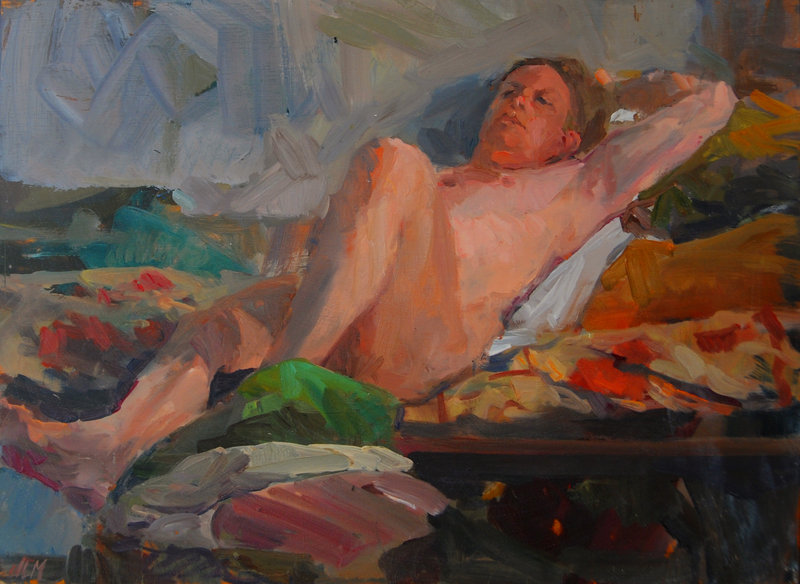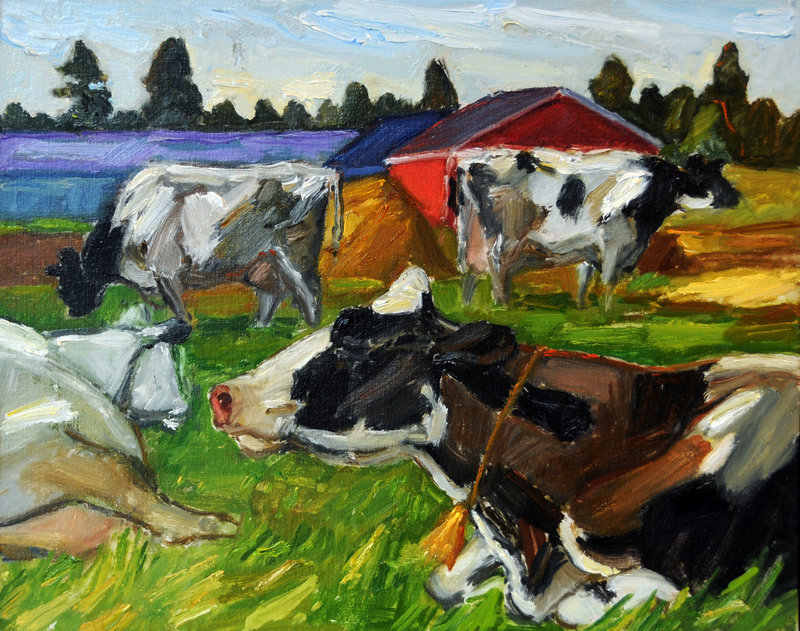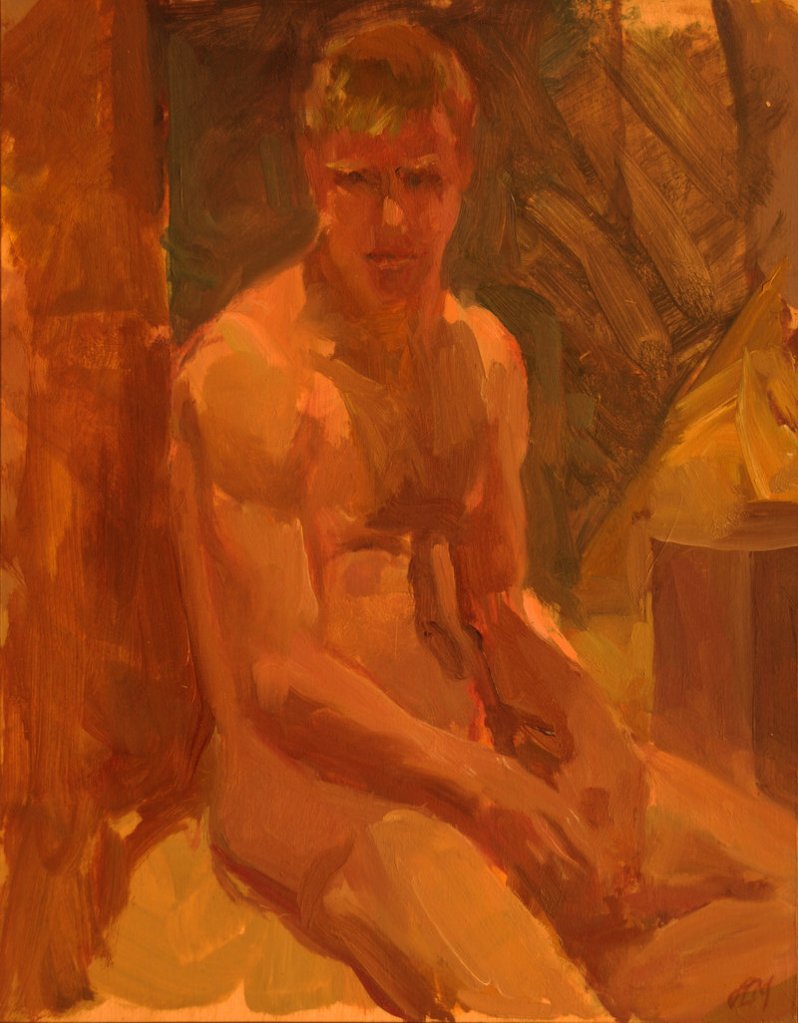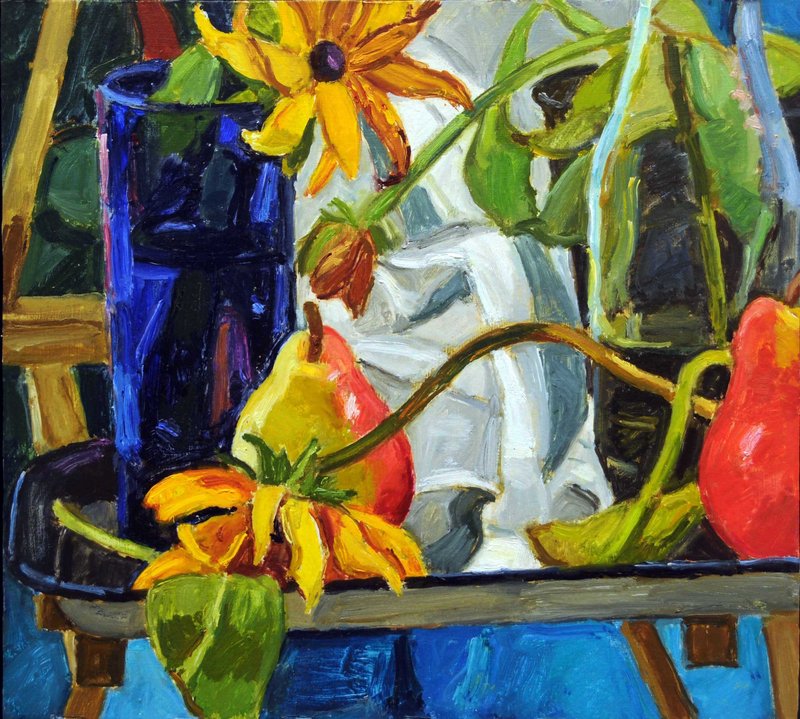The two-person show of work by Janet Manyan and Sharon Yates at Frost Gully Gallery in Thomaston is a really nice painting show. The pieces are all intimate in scale and handsomely installed. They alternate between Manyan’s nudes and then Yates’ landscapes and still lifes.
If Manyan’s nudes were all shown together, they might be seen as a bunch of naked people. But interspersed with still lifes and landscapes, they appear for what they are: Paintings in a genre steeped in tradition.
Yates is a terrific painter of note whose amazing surfaces and brushwork are lively and complex. Manyan’s brushwork is lighter, quicker and more liquid than Yates’ tighter and thicker approach.
Yates is probably best known for her landscapes with cows, which are neither flatly stylized nor cartoonishly anthropomorphized. Her works’ dynamism seems to be an effect of her painting en plein air — the challenge of finishing a painting on site and in one shot. Completed at a life drawing session from the model holding a single pose, Manyan’s nudes have a similar feel.
Yates’ “Brown’s Place” features two cows lying in a field with several farm outbuildings on the high horizon behind them. A jangly staccato row of small and squishy dark green trees pushes the thin band of white blue sky up to the top edge of the picture. The greens of the brushy field of tall grass have been faded to ochre by the late summer sun.
The cows both face rightward, playing up the sense of the passage of time hinted at by the picture’s insistence on rhythm rather than pastoral idyll. These rhythms, however, also play between the cows and the buildings in a brilliantly unexpected way as Yates echoes the vaguely salt-box architecture in the similarly left-to-right structural logic of the cows.
The cow-as-architecture theme is handled with particular wit in Yates’ “Smith Farm #3,” in which a cow’s back — from butt to shoulder — aligns perfectly with a distant red barn’s roof. But she also uses the cow’s neck line and body with the roof to create an elegant lozenge form that moves our eye away from the shared, flat line. In “Totton’s Herd,” the sculptural complexity of the recumbent cow in the foreground is striking, but compellingly honest.
I like it that Yates’ cow pictures remind me of Theo van Doesberg’s famous “Abstraction of a Cow, Four Stages” at MoMA.
Yates’ still lifes invert the Impressionism effect: From afar, they are chaotic, but when you get close to them, her brushwork takes over and reveals their impressively painted passages, details and orchestration.
Manyan’s nudes represent a different kind of accomplishment. We forget both how important the genre of the nude (and working from the model) used to be for ambitious painting. Nudes not only adorned male-dominated spaces like dens and men’s clubs, but civic spaces as well. (Remember when Attorney General John Ashcroft spent $8,000 on drapes to hide the “Spirit of Justice” statue? I do.)
While most of the nudes are female, the strongest painting is of a male. It’s not that the figure is rendered better, but rather because the brushwork is so good everywhere in “Matt, thinking” — especially the white drapery in the background.
Another male, “Jerry,” features incredible passages connecting the standing figure’s jaw to his neck, and then the revealed yellow flickers along the highlight edge running down his side.
Most impressive to me is “Karen,” because the model’s body language is quietly demure, yet active and fascinatingly complex.
She is seated in profile but with her right arm back and shoulder raised — thereby opening her torso toward the viewer. Her left shoulder is dropped and her arm politely draped over her crossed legs. Her right breast — in highlight — points slightly toward you with the other in shadow pointing slightly away; their differing orientations mediate her body’s twist while creating a volume for her personal space. It looks simple and feels comfortable, but it’s brilliantly observed and executed.
The thing about painting human bodies is that we don’t just know what they look like, but we live in them and it’s only through them that we experience the world. You don’t have to know a lick about art to tell if something is wrong with a face, a hand or a body.
But on the flip side, we can’t get outside of our bodies or away from subjectivity. My favorite nudes are the two “Jessica” paintings, but I had to question if it was because of the quality of the painting or the extraordinarily beautiful model. To my surprise, it turned out to be their compositions more than anything else: Both place the model in profile against the surface of the painting and then allow her hips and legs to make subtle spatial gestures. (The postcard doesn’t do “Jessica, Again” justice — it’s about softly rich textures rather than hotly lit volumes.)
I get the idea that Manyan’s favorite is “Paula” — a supremely confident model of a certain age. She is a woman to admire.
I admire Yates and Manyan. Both are excellent painters and together, they are even better.
Freelance writer Daniel Kany is an art historian who lives in Cumberland. He can be contacted at:
dankany@gmail.com
Copy the Story Link
Send questions/comments to the editors.






Success. Please wait for the page to reload. If the page does not reload within 5 seconds, please refresh the page.
Enter your email and password to access comments.
Hi, to comment on stories you must . This profile is in addition to your subscription and website login.
Already have a commenting profile? .
Invalid username/password.
Please check your email to confirm and complete your registration.
Only subscribers are eligible to post comments. Please subscribe or login first for digital access. Here’s why.
Use the form below to reset your password. When you've submitted your account email, we will send an email with a reset code.